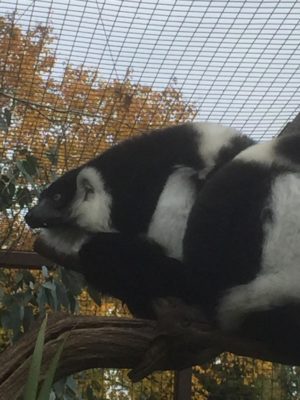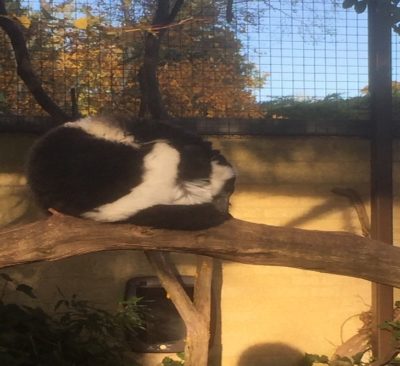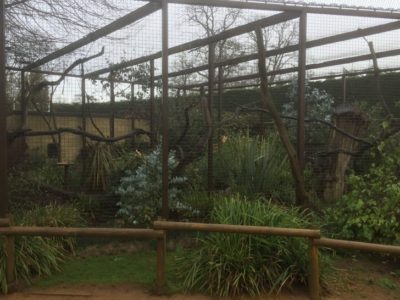Hello again lemur fanatics.
I’m back and I would like to talk about Black and White Ruffed Lemurs. The clue is in their name, easily recognisable by their fluffy back and white fur.
At Cotswold Wildlife Park and Gardens, there are three Female Black and White Ruffed Lemurs. For their safety and everyone who visits the Park’s safety, the lemurs are kept in their own spacious enclosure. Ruffed lemurs are very territorial. If they were in the walkthrough, they would probably chase all the other lemurs all the time. I can only describe the ruffs’ calling as a roaring bark which usually scares everyone on approaching the walkthrough. This always makes me laugh as the mums and dads become just as scared as their children. But, as soon as I explain the ruffs are not actually in the walkthrough, they are very overcome with joy and breathe a bit easier.
Ruffed lemurs are among the loudest animals at Cotswold Wildlife Park. Having spent some time with the Ruffed Lemurs, towards me they are so sweet and gentle. I really do envy the keepers who look after them.
Let’s meet the trio!
This is Lalaina. The dominant one. She is 9 years old. She has a lot more of the white markings compared to the others.

This one is Natty. She is the second in command and she is 17. She is easier to recognize as she has a much darker snout than the rest.

And last, this is Sentenza, my favorite. She is the submissive one, the oldest and wisest at 20 years old. This one is last to eat. She is very vocal but it’s only in a submissive way to let her friends know she can wait.

Ruffed Lemurs in the Wild in Madagascar
In the wild, ruffed lemurs spend most of their time high up in the rainforest trees only coming down to the forest floor to eat if there is no food in the trees.
As of 2012, the IUCN Red List has listed the Black and White Ruffed Lemurs as Critically Endangered. With all lemurs, their population is decreasing. These ruffed lemurs are located in the eastern strip of Madagascar where luckily there are some protected rainforests for them to live.
Released into the Wild
Many people might remember that in the late 90’s/early 00’s, a reintroduction to the wild was performed for 13 lucky black and white ruffs who had been raised in human care. The program was organised by the Madagascar Fauna Group and the Duke Lemur Center in America. These 13 were released in groups and all had radio transmitting collars on so they could be tracked. Unfortunately at least five were killed by their predator the Fossa.
Of the surviving lemurs, at least one male that they know of has successfully integrated into a wild group and has reproduced. Future programs are officially halted due to habitat loss which is very sad.
Threats to Ruffed Lemurs
Their population in the last 27 years has dropped by 80% which is scary for the years to come. Just like all other lemurs, there are great threats to their existence.
- Bushmeat. Poachers that go into the forests hunting for rosewood spend a lot of time in the forest and sometimes capture them for their meals. Also, villagers who struggle to feed their families sometimes hunt lemurs for food.
- Slash and Burn. This is a method of agriculture in the communities of Madagascar. It strips the lemurs habitat to grow crops or to use the wood for fire or fuelwood, as it’s called.
- Predators. I already mentioned the fossa that preys on the ruffs but also ring-tailed mongoose and brown-tailed mongoose hunt the ruffs. The Black and White Ruffed Lemurs are at great risk when they nest.
Fun Fact: The Black and White Ruffed Lemurs along with the Red Ruffed Lemurs are the largest lemurs in their family of Lemuridae, which I found very interesting.

Organizations that need your help
- Most zoos and wildlife parks are always after volunteers. Don’t be afraid to get involved.
- From what I’ve read, the Durrell Wildlife Conservation Trust does amazing work. Check it out!
- The Wildlife Conservation Society supports lemur conservation in the Makira National Park in Madagascar which has at least 7 types of lemurs.
Like my last blogs, I can keep naming organisations that help, but without boring everyone I’ll name a few more in my next blog.

Coming Up
I hope everyone enjoyed World Lemur Day as much as I did. Social media was alive with lemurs everywhere which was great exposure.
My next blog might be a while as I’m currently studying Zoology and trying to become a zoo keeper.
Join me next time on a lemur’s apprentice, where I’ll be talking about King Julian, but really it should Queen Julian.
Want to support the Black and White Ruffed lemur?
Support these NGOs that works with this species! Learn about the Cotswold Wildlife Park
